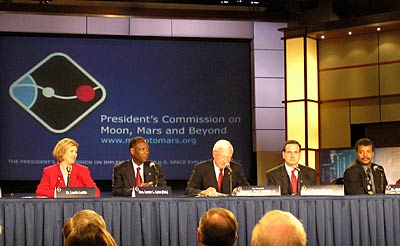What hath Aldridge wrought?by Taylor Dinerman
|
| The Aldridge Commission’s concept of “go as you pay” is the most important part of their report. |
The ISS program is the prime example of NASA’s cost estimation and budget problem. The agency canceled the Crew Return Vehicle/X-38 program simply because they could not find room for it in the budget. They were unable to come up with a reasonable way of saying, “Let’s put this on the back burner and build it when our budget problems are not quite so severe.” The cancellations of the Transhab Module, the Interim Control Module and the Habitat Module were all wasteful decisions, made largely because of the budget process rather than an actual lack of long-term money.
The ISS operates under a budget ceiling system that prevents NASA from spending more than a set amount (roughly three billion dollars) every year. The Congress has appropriated more than this on occasion and could do so in the future, but only if NASA can make the case for it. In the case of the ISS, a “go as you pay” approach would have allowed the agency to put the canceled systems into deep hibernation, and then to revive them if and when Congress agreed to provide additional funding.
The Department of Defense provides Congress every year with an “unfunded requirements” list. The legislators have the discretion to spend or not spend money on items from inside this “basket.” A reformed NASA would put together such a list based on the needs of the four new Mission Directorates. Such a system would give lawmakers some flexibility and would allow them to put their collective stamp on the government’s space program without harming the overall exploration vision.
This problem is not confined to NASA. There is a serious mismatch between large-scale, expensive research projects and the annual congressional budget cycle accompanied by elections for the House every two years. Neither of these factors is going to change. The budget system is a delicate set of compromises that is barely adequate in good times and comes close to being a disaster in wartime. It will, however, almost certainly not be reformed because it suits the way business is done in Washington and it gives almost every interest group a chance to have their needs acknowledged. The election cycle is in the Constitution and, unlike anywhere else in the world, is a major factor in the amazing ability of the American people to keep the political class on a short leash.
| Go as you pay will force NASA and its contractors to abandon the schedule-driven models of the past. |
As we saw with the ISS problems and, even worse, with what happened to the Superconducting Supercollider, large-scale projects are vulnerable to either cancellation or being twisted into near uselessness. Go as you pay, if it results in a real cultural change at NASA, will allow for a much better match between the funding needs of ambitious projects and the reality of the way the federal budget operates. In fact it, could serve as a model for other government entities that seek to accomplish long-term expensive projects.
Go as you pay will force NASA and its contractors to abandon the schedule-driven models of the past, not just that of Apollo, but also of the shuttle and the ISS, which were both scheduled fairly tightly. The shuttle, for example, was supposed to have been finished in 1978 or 1979. Inadequate funding in the early seventies pushed the first launch back to 1981. The pressure to get the system “operational”, and the backlog of satellites waiting to fly, may have been a factor in the Challenger disaster. Problems with the Russians and with the shuttle have constantly pushed the ISS completion date to the right. The heartache of trying to keep to an impossible schedule is a factor in the constant cost overruns.
A more relaxed attitude, one that says, “We’ll finish the project when we have the money to do so,” will cause lots of problems for both NASA and for the contractors. Turning the NASA centers into federally funded research and development centers (FFRDCs) is the key to making it work. This will probably be the hardest part of the program, both from a political point of view and in its institutional aspect. That is a subject for a future article.
The commission actually proposes an analogy that has the potential to change the NASA operating and planning culture in a way that has not been done since it was founded in 1958. “The pace of cancer research, but not the outcome, is defined by a tough, prudential judgment: annually, how much can we afford?” If space exploration becomes comparable to the war on cancer rather than to the “man-on-the-moon-before-this-decade-is-out,” the political pressure to overpromise and underestimate costs would no longer be so powerful. If this mentality takes hold, then NASA will move away from the traditional aerospace contracting model, and grow more towards a new, and less wasteful, way of doing business.
